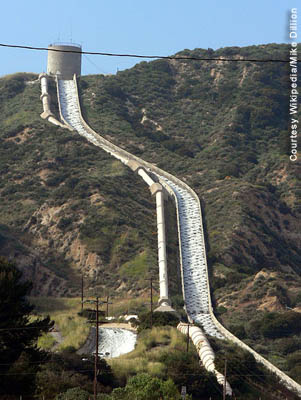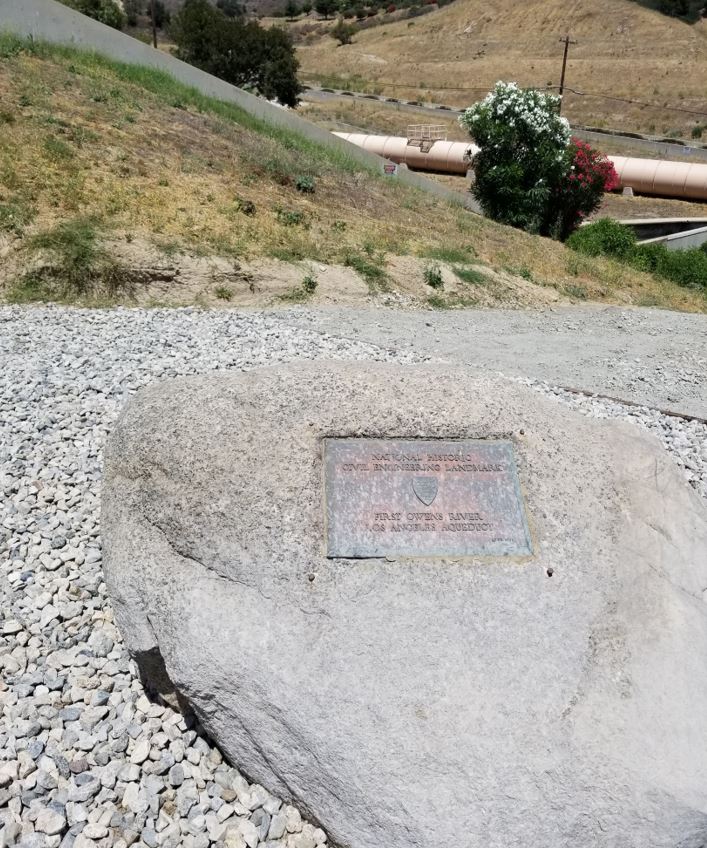First Owens River-Los Angeles Aqueduct
to Los Angeles, CA
36 58 32.4 N, 118 12 38.0 W

The population in Los Angeles was growing rapidly at the turn of the century, and the demand for water in this semi-arid region was critical. In 1904, three Los Angeles engineers - William Mulholland, Frederick Eaton and J.B. Lippincott - developed a plan for future sources of water for the thirsty city. The men recommended construction of a 233-mile-long aqueduct from the Owens River to Los Angeles. Faced with a prolonged drought at the time, citizens approved a $23 million bond issue (roughly equivalent to $1.5 billion today) to build the aqueduct.
The aqueduct began supplying water from the eastern slope of the Sierra Nevada to Los Angeles in 1913. It was considered a miracle of engineering at the time, because the abundant water flowed the entire distance between Owens Valley and Los Angeles by gravity alone.

Facts
- In 1906. the City of Los Angeles employed three of the most eminent civil engineers in the U.S. - including Frederick P. Stearns, then president of the ASCE, John R,. Freeman, a hydraulics specialist, and James D. Schuyler, designer of large dams - to verify that Mulholland's plan was viable.
- The aqueduct proper includes a series of five storage reservoirs, 142 tunnels totaling 52 miles in length, 12 miles of inverted steel siphons, 24 miles of unlined conduit, 37 miles of open, concrete-lined conduit, and 97 miles of covered conduit.
- Most of the thirteen inverted siphons, with a combined length of 49,575 feet, are supported above-ground on piers.
- From its intake in Owens Valley, the aqueduct passes over foothills, through mountains, and across the Mojave Desert into Los Angles, flowing all the way by gravity alone.
- The aqueduct provided the City of Los Angeles with a uniform annual flow of 440 cubic feet per second, enough to supply the population of two million for the following 20 years, until the system needed expansion people flocked to southern California.
- The rugged topographic relief along the eastern face of the Sierra Mountains necessitated construction of many tunnels and dramatic canyon crossings. Most of the rock tunnels were driven with machine drills.
- Despite the fact that Elizabeth tunnel - 26,780 feet through solid granite of the San Fernando Mountains - was one of the most difficult construction tasks, the American record for hard rock tunnel driving - 604 feet in one month - was established there.
- The materials of construction were conveyed up the mountainsides with aerial trams.
- Great quantities of water were needed for construction, particularly for the cement-lined conduit and concrete structures. Because no water was available in most areas of the deserts, the City of Los Angeles laid a 268-mile pipeline, connected with large storage tanks, along the aqueduct route.
- The Southern Pacific Railroad built a rail line, completed in 1910, to transport the enormous loads of construction material and equipment. Additionally, 505 miles of roads were necessary.
- Mule teams were deemed too expensive to use for short-distance hauling, so the aqueduct builders invested in a recent technological development, the caterpillar tractor. After an initial trial period with one tractor, the city government bought 28 more. Eventually maintenance and repair proved too costly, so the city crews reverted back to using mules.
- Power for construction was generated by two hydroelectric plants built especially for the project: the Cottonwood and Division Creek plants. Since then, several hydroelectric plants have been built by the City of Los Angeles along the Owens River and the aqueduct to supply power for the municipal electrical utility.
- An entire town, called Monolith, was created solely to produce cement - 1000 barrels every 24 hours. The mill was supplied with limestone and clay from deposits in the Tehachapi Mountains.
- The aqueduct is one of the most controversial water projects in U.S. history. The project took all of the water in the Owens River for the City of Los Angeles, leaving the former Owens Lake as a dry salt and alkali flat. This generated much enmity among the agricultural community of the Owens Valley.

